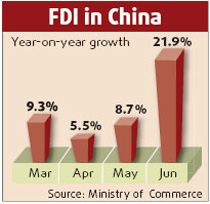China's consumer price index (CPI), a main gauge of inflation, rose 6.5 percent year-on-year in October, the National Bureau of Statistics (NBS) said on Tuesday.
The figure was the same as in August, when the CPI increase reached an 11-year monthly record. The rate of increase in the CPI eased slightly to 6.2 percent in September.
Consumer prices rose 4.4 percent in the first ten months of the year, compared with 4.1 percent for the January-September period.
Analysts said the rise in the October CPI was largely due to higher pork and food prices.
"As winter comes, demand for pork and other food products is increasing by a large margin, so food prices went up in October," said Yao Jingyuan, chief economist with the NBS.
Food prices jumped 17.6 percent in October, 0.7 percentage points higher than in September but 0.6 percentage points lower than in August, the bureau said.
In October, grain prices were up 6.7 percent, pork prices 54.9 percent, meat and poultry 38.3 percent, cooking oil 34.0 percent, aquatic products 7.0 percent, fresh vegetables 29.9 percent, and fresh fruit, 8.5 percent.
Prices of non-food products rose 1.1 percent.
Transport and telecommunications prices dropped 1.7 percent and clothes prices slid 1.3 percent, but housing prices were up 4.8 percent.
The bureau said the CPI in October surged by 6.1 percent in cities and 7.2 percent in rural areas, but it predicted inflation would ease in November and December.
The Producer Price Index (PPI) for industrial products, which affects consumer prices, rose 3.2 percent year-on-year in October, said the bureau on Monday.
Chinese Premier Wen Jiabao said on Monday that prices were stable from 2003 to 2006 but climbed rapidly this year. The main reasons for the recent price hikes included rising international crude oil and grain prices and higher prices of other foodstuffs, driven by domestic price hikes of pork and cooking oil
"The huge payments and trade surpluses boosted liquidity, which in turn fueled inflation," said Long Guoqiang, an expert at the Macroeconomic Research Institute of the Development Research Center of the State Council.
China's trade surplus in October rose 13.5 percent from a year earlier to a new record of US$27.05 billion, customs officials said on Monday.
Long said that the government would continue to adopt macroeconomic tightening measures to ease inflationary pressures and solve problems, including excess liquidity and a huge international payments surplus.
In its latest bid to curb credit growth, the central bank announced on Saturday that it would raise commercial banks' reserve ratio by half a percentage point, effective November 26. It was the ninth hike this year.
The premier said the government would continue to take measures to ensure sufficient supply and stabilize prices.
He said the government was trying to ensure adequate supplies by giving support to producers of pork, cooking oil and dairy items and encouraging imports to contain price hikes.
"Although the Chinese economy has not overheated, the high CPI is a warning signal -- the government should avoid a new round of heated investment, which, if transmitted to downstream enterprises, could lead to overall price hikes," said Tang Min, chief economist with the Asian Development Bank Mission in China.
Tang contended that the increasing disparity between interest rates and consumer prices could lead the central bank to raise rates further this year.
"Dwindling farmland is the cause of food price hikes," said Wang Jian, an economist with China Macroeconomic Information Network. "The government should subsidize low-income individuals and protect farmland from illegal abuse."
"If the next two months see new highs, the full-year CPI would be above 5 percent." said Wang.
(Xinhua News Agency November 14, 2007)


